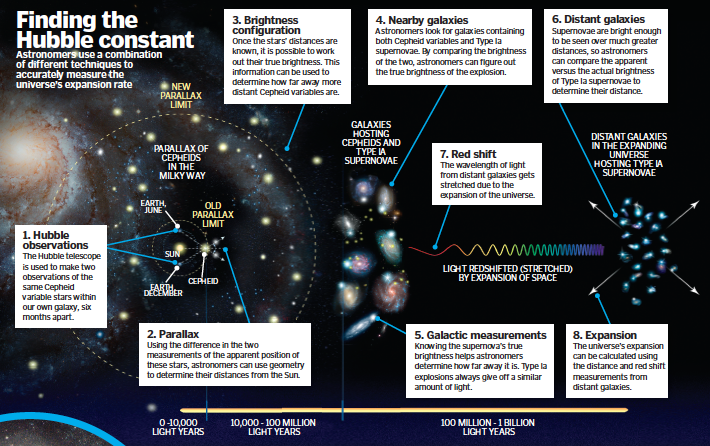Expansion of the universe
In 1929, American astronomer Edwin Hubble announced a truly ground-breaking discovery: the universe was expanding. By observing the light from distant galaxies, Hubble found that their wavelengths were stretched out (known as redshift, as the light is shifted towards the red end of the light spectrum), and the further away the galaxies were, the redder shifted the light was. This observation only made sense if the universe was expanding. The extent of a galaxy’s redshift indicates the speed at which it is moving. Hubble found that a galaxy’s distance and speed, and therefore the rate of the expansion of the universe, were directly linked by a constant value, which is known as the Hubble constant. In 1929, the constant’s value was 500 kilometres per second per megaparsec (one megaparsec is approximately 3.26 million light years), but this figure was based on limited data. Astronomers later discovered that Hubble was incorrect by approximately a factor of ten, but over the years – with improved data and techniques – they have been able to refine the Hubble constant’s value. In 2016, scientists were able to make the most precise estimate yet: 73.2 kilometres per second per megaparsec. This more accurate data led to the discovery that the universe is, in fact, expanding between five and nine percent faster than previously expected.

What are Cepheid variables?
Cepheid variables are a group of stars that are very large and luminous. The majority of stars become Cepheid variables after the red giant phase towards the end of their lifespans, and pulse as they expand and contract, glowing brightly and fading over regular intervals. The period of a Cepheid star’s brightening and dimming pattern can last from one to 100 days and is directly related to its true brightness. By comparing the star’s true brightness to its apparent brightness (how bright it seems from Earth), astronomers can calculate how far away it is. Cepheid variables have been very useful distance measuring tools since their period-luminosity relationship was discovered by American astronomer Henrietta Leavitt in 1912.
For more information about science and technology, visit our website now. If you have a tablet or smartphone, you can also download the latest digital version onto your iOS or Android device. To make sure you never miss an issue of How It Works magazine, subscribe today!
Farthest star ever seen in the universe detected
Do we live in a parallel universe?
The Giant Magellan Telescope: Will it unlock the secrets of the universe and find alien life?





